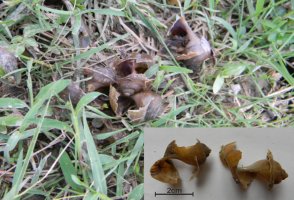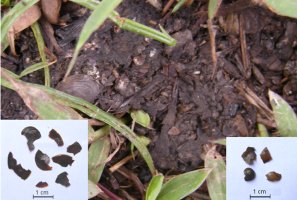IUCN/SSC Otter Specialist Group Bulletin

|
©IUCN/SCC Otter Specialist Group Volume 28 Issue 1 Pages 1- 60 (January 2011) Citation: Aadrean, Novarino, W. and Jabang (2011). A Record of Small-Clawed Otters (Aonyx cinereus) foraging on an Invasive Pest Species, Golden Apple Snails (Pomacea canaliculata) in a West Sumatra Rice Field . IUCN Otter Spec. Group Bull. 28 (1): 34 - 38 A Record of Small-Clawed Otters (Aonyx cinereus) foraging on an Invasive Pest Species, Golden Apple Snails (Pomacea canaliculata) in a West Sumatra Rice Field Aadrean1, Wilson Novarino and Jabang 1 Biology Department of Andalas University, West Sumatra, Indonesia. email: a2drean@gmail.com |


 |
| Abstract: A small-clawed otter (Aonyx cinereus) survey in West Sumatran rice fields was conducted from April to September 2010. During this survey, golden apple snail (Pomacea canaliculata) shell remains were found on a rice field bank as suspected prey remains of small-clawed otters. This suspicion was later proved by the occurrence of snail material (pieces of operculum and shell) in otter spraints. This is the first evidence of small-clawed otters foraging on this invasive pest species. Characteristics of the shell remains and spraints are described. |
| Keywords: small-clawed otter, invasive species, spraint, snail shell, operculum |
| Française | Español | Bahasa Indonesia |
INTRODUCTION
An otter survey was conducted in rice fields in the Padang Pariaman District of the West Sumatra province from April to September 2010. Surveyed locations are rice fields artificially irrigated from the Bendungan Anai dam. This dam irrigates 13,640 hectares of rice fields in four sub-districts: Lubuk Alung, Sintuk Toboh Gadang, Batang Anai, and Ulakan Tapakis. The otter survey used a line transect method by following rice field banks and irrigation channels (Aadrean et al., 2010). Tracks, spraints and other otter signs were collected.
During this survey, we found shell remains of the golden apple snail (Fig. 1). at 0°42.332'S and 100°17.360'E. We suspected that these snails had been preyed on by small-clawed otters. The shells appeared to have been bitten, with regular cracks following the shell spiral to get at the meat. This damage pattern differed from that produced by human pest control – in the latter case, the snails are captured by hand and put on the rice field bank to dry out and die, and usually either complete shells are found, or the shells are irregularly crushed if they have been walked on by humans passing along the bank.
 |
|
Figure 1.
Snail shell remains found on a rice field bank. Insert right bottom: Morphology and measurement of shell remains (click for larger version) |
The predated snail shell remains were found in groups containing 4-7 shells per group. They were found lying on a rice field bank behind small irrigation channel near an otter spraint site, during the planting season when water levels are kept low.
17 out of a total of 28 otter spraints found contained this snail material. Spraints consisting predominantly of snail remain are black in color, and sometimes also contain undigested snail eggs of pink color. If in fresh condition, these spraints are more slimy than usual, very rancid with a rotten snail smell and sometime snail meat with white slime was found in them. After few days, and having been washed by rain, pieces of operculum and shell become apparent (Fig. 2).
Pieces of operculum found in otter spraints were compared with known golden apple snail operculum. Their identification was confirmed by the similarities of growth spiral morphology. In this survey, golden apple snails were observed to be a major pest in all of this rice field area.
The golden apple snail (Pomacea canaliculata) is a native species from South America, which has become an invasive species throughout the world. It was introduced to Indonesia as aquarium fauna in 1981. However, by few years after its introduction, the golden apple snail had became a major pest of rice in Java and Sumatra and is estimated to have reduced yields by 15% (Suharto, 2002). Because of great impact of this invasive species, the IUCN Invasive Species Specialist Group (ISSG) has placed it among the top 100 of the "World's Worst" invaders (Lowe et al., 2000)
Invasive species arriving in an area will affect the whole ecosystem. The role of any predator as controlling factor will therefore be important. As one of the top carnivores, small-clawed otter occurrence in West Sumatra rice fields has been confirmed in a previous study (Aadrean et al., 2010). However, small-clawed otter were mainly found to be crab eaters, and molluscs were not prominent in its diet (Kruuk et al., 1994; Hon et al.,2010).
Previously, Wright et al. (2008) have reported the occurrence of golden apple snails in hairy-nosed otter habitat in Cambodia, and speculated that they might be a potential food source for otters; it is as yet unclear whether this will be a net threat or benefit for the hairy-nosed otter. Our findings reveal utilization of this invasive pest species as part of the diet of small-clawed otters. Predation on exotic or invasive species by otters has been also reported for crabs (Weber, 2008) and fish (Blanco-Garrido et al., 2008; Porciuncula and Quintela, 2010).
This record contributes to knowledge of otters foraging on exotic or invasive species in aquatic environments. However, we could not establish whether this was a nutritious additional food source, or an indicator of lack of indigenous, and possibly preferred food, as described by Smith (1990): in feeding preferences, a consumer will select less nutritious species if high quality alternatives are rare. Here it may, however, just indicate the opportunistic nature of otter diet. If this could be established, it may help in devising conservation measures for native prey species. Further diet composition data from spraint analysis is needed to establish any degree of preference for this snail, and the quality and quantity of alternative food in snail-containing areas compared to areas without the snail.
 Acknowledgements - Thanks to Ruth Davidson, Claudio Chehebar and Lorenzo Quaglietta for their help and suggestions on the manuscript, and Lesley Wright for the English revision. This survey is part of West Sumatra Otter Project funded by Rufford Small Grants.
Acknowledgements - Thanks to Ruth Davidson, Claudio Chehebar and Lorenzo Quaglietta for their help and suggestions on the manuscript, and Lesley Wright for the English revision. This survey is part of West Sumatra Otter Project funded by Rufford Small Grants.
REFERENCES
Aadrean, Salmah, S., Salsabila, A., Rizaldi, Janra, M.N. (2010). Tracks and other signs of otters in rice fields in Padang Pariaman, West Sumatra: a preliminary study. IUCN Otter Spec. Group Bull. 27: 6-11.
Blanco-Garrido, F., Prenda, J., Narvaez, M. (2008). Eurasian otter (Lutra lutra) diet and prey selection in Mediterranean streams invaded by centrarchid fishes. Biol. Invasions. 10: 641-648.
Hon, N., Neak, P., Khov, V., Cheat, V. (2010). Food and habitat of Asian small-clawed otter in northeastern Cambodia. IUCN Otter Spec. Group Bull. 21: 12-23.
Kruuk, H., Kanchanasaka, B., O'Sullivan, S., Wanghongsa, S. (1994). Niche separation in three sympatric otters Lutra perspicillata, L. lutra and Aonyx cinereus in Huai Kha Khaeng, Thailand. Biol. Conserv. 69: 115-120.
Lowe, S., Browne, M., Boudjelas, S., De Poorter, M. (2000). 100 of the World’s Worst Invasive Alien Species A selection from the Global Invasive Species Database. IUCN Invasive Species Specialist Group (ISSG).
Porciuncula, R. A., Quintela, F. M. (2010). A record of invasive black catfish (Trachelyopterus lucenai) predation by the neotropical river otter (Lontra longicaudis) in Restinga of Rio Grande, southern Brazil. IUCN Otter Spec. Group Bull. 27: 50-53.
Smith, R. L. (1990). Ecology and Field Biology, fourth edition. Harper Collins Publishers Inc. New York.
Suharto, H. (2002). Golden Apple Snail, Pomacea canaliculata (Lamarck) in Indonesia. In: Wada, T., Yusa, Y., Joshi, R. C., Ghesquiere, S. (eds.). Proceedings of the special working group on the golden apple snail (Pomacea spp.). The Seventh International Congress on Medical and Applied Malacology (7th ICMAM).
Weber, A. (2008). Predation of invasive species Chinese mitten crab (Eriocheir sinensis) by Eurasian otter (Lutra lutra) in the Drömling Nature Reserve, Saxony-Anhalt, Germany. IUCN Otter Spec. Group Bull. 25: 104-107.
Wright, L., Olsson, A., Kanchanasaka, B., (2008). A working review of the hairy-nosed otter (Lutra sumatrana). IUCN Otter Spec. Group Bull. 25: 38-59.
Résumé : Prédation d’une Loutre Cendrée (Aonyx cinereus) sur une Espèce Invasive, l’Escargot Jaune (Pomacea canaliculata), dans un Champs de Riz de l’Est de Sumatra
Une enquête de terrain sur la Loutre cendrée (Aonyx cinereus) a été menée dans les champs de riz de l'ouest de Sumatra d'avril à Septembre 2010. A cette occasion, des restes d’Escargot jaune (Pomacea canaliculata) ont été trouvés sur une rive d’un champ de riz et considérés comme la proie d’une loutre cendrée. Cette suspicion a été prouvée plus tard grâce à la découverte de restes d'escargot dans des épreintes (pièces de l'opercule et morceaux de coquille). C'est la première donnée de prédation de la Loutre cendrée sur cette espèce invasive. Les caractéristiques des restes de coquille et les épreintes sont ici décrits.
Revenez au dessus
Resumen: Registro de la Nutria le uña Pequeña Asiática (Aonyx cinereus) Alimentandose de Caracoles Manzana Pomacea canaliculata), una Especie de Plaga Invasora en un Campo de Arroz en West Sumatra.
Un seguimiento de la nutria de uña pequeña asiática (Aonyx cinereus) a los campos de arroz en West Sumatra fué conducido desde abril a septiembre de 2010. Durante este seguimiento, residuos de la concha de caracoles manzana (Pomacea canaliculata) fueron hallado en una orilla del campo de arroz como presunta presa de nutrias de uña pequeña asiática. Esta sospecha fué luego confirmada por la aparición the residuos de caracol (piezas de opérculo y concha) en las heces estudiadas. Esta es la primera evidencia de nutrias de uña pequeña alimentandose de esta especie de plaga invasora. Las características de los residuos en heces son descritas.
Vuelva a la tapa
Ringkasan
Sebuah Catatan Pemangsaan Jenis Hama Invasif, Keong Mas (Pomacea canaliculata) Oleh Berang-Berang Cakar Kecil (Aonyx cinereus) Di Area Persawahan Sumatera Barat
Survei berang-berang cakar kecil di area persawahan Sumatera Barat telah dilaksanakan dari April sampai September 2010. Selama survei ini, sisa cangkang keong mas (Pomacea canaliculata) ditemukan di pematang sawah. Hal ini diduga sebagai sisa hewan mangsa dari berang-berang cakar kecil. Dugaan ini kemudian dibuktikan dengan keberadaan materi keong mas (pecahan operculum dan cangkang) di dalam kotoran berang-berang. Ini merupakan bukti pertama berang-berang cakar kecil memangsa jenis hama invasif ini. Karakteristik sisa cangkang dan kotoran dideskripsikan.
Kembali ke atas
